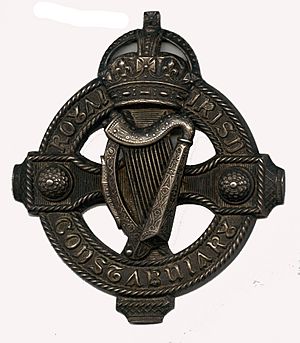Royal Irish Constabulary facts for kids
The Royal Irish Constabulary (RIC) was the main police force in Ireland when Ireland was part of the United Kingdom. It was also known by its Irish name, Constáblacht Ríoga na hÉireann.
The RIC was created by a special law in 1814. A famous person named Sir Robert Peel helped make this law happen. The police force was given its "Royal" name by Queen Victoria in 1867. This was to show thanks for their loyalty during a time of unrest in Ireland. Most of the police officers in the RIC were Roman Catholics from Ireland.
By 1870, the RIC also took over the police duties in the cities of Londonderry and Belfast. They worked alongside the Dublin Metropolitan Police, which looked after Dublin. The RIC stopped operating in 1922 when Ireland became independent from the UK. In the new Irish Free State, a new police force called the Civic Guard (now Garda Síochána) took its place. In Northern Ireland, the Royal Ulster Constabulary (RUC) was formed to continue police work.
Contents
What Was the Royal Irish Constabulary?
The Royal Irish Constabulary was a police force that kept law and order across most of Ireland. They were responsible for many things, like stopping crime, keeping the peace, and helping with official tasks. They were a very organized group, similar to a military force in some ways, but their main job was policing.
How the RIC Started
The RIC began in 1814, but it wasn't called the Royal Irish Constabulary right away. It was first known as the Peace Preservation Force. Its main goal was to help keep order in different parts of Ireland. Over time, it grew and became more organized. In 1822, a new law brought together many local police groups into one larger force called the Irish Constabulary. This made policing more consistent across the country.
Why the RIC Was Important
The RIC played a big role in daily life in Ireland for over 100 years. They were present in almost every town and village. Their duties included:
- Stopping crime and catching criminals.
- Keeping the peace during public events or disagreements.
- Helping with official tasks, like collecting information for the government.
- Supporting landowners during difficult times, such as when people were asked to leave their homes.
The force was known for its discipline and organization. Many Irish men joined the RIC, making it a significant employer in the country.
The End of the RIC
The Royal Irish Constabulary was disbanded in 1922. This happened because Ireland gained independence from the United Kingdom. With the change in government, new police forces were needed for the new states.
- In the Irish Free State (which is now the Republic of Ireland), the Garda Síochána was created.
- In Northern Ireland, the Royal Ulster Constabulary (RUC) was formed to continue policing.
Many former RIC officers had to choose whether to join the new forces or find other work. The end of the RIC marked a big change in Irish history.
Images for kids
-
Station badge of the "Irish Constabulary" (on display at the Garda Museum)
See also
 In Spanish: Royal Irish Constabulary para niños
In Spanish: Royal Irish Constabulary para niños








